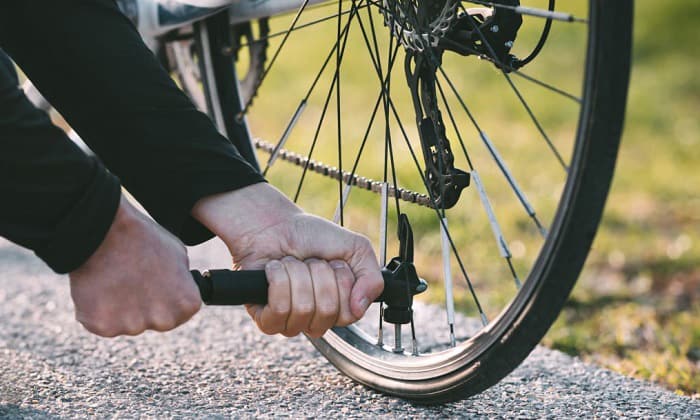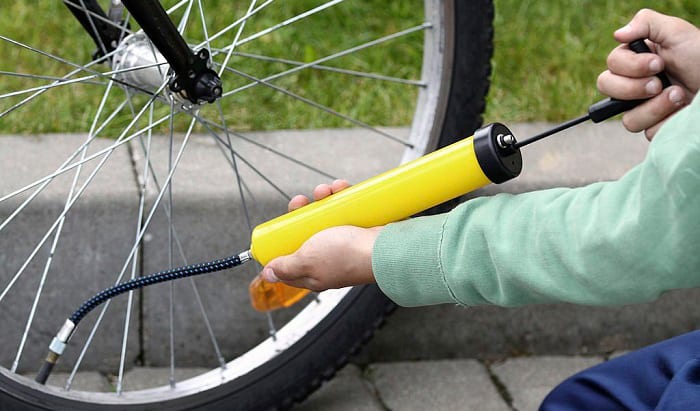Why You Need to Know This Essential Bike Maintenance Skill
Proper tire inflation is crucial for bike safety, performance, and longevity. Riding on under-inflated tires can lead to reduced traction, increased risk of punctures, and decreased fuel efficiency. Moreover, it can also affect the overall handling and stability of the bike, making it more difficult to control. On the other hand, over-inflated tires can be just as dangerous, causing the bike to vibrate excessively and increasing the risk of a blowout. Knowing how to inflate a bike tire without a pump is an essential skill for any cyclist, as it allows you to ensure optimal tire pressure even when a pump is not available. This skill is particularly useful for cyclists who frequently ride in remote areas or participate in long-distance tours. By learning how to inflate a bike tire without a pump, you can enjoy a safer, more comfortable, and more efficient ride. In fact, mastering this skill can be a lifesaver in emergency situations where a pump is not available. With this knowledge, you can confidently tackle any terrain, knowing that your tires are properly inflated and ready for the challenge.
Understanding Tire Pressure: What You Need to Know
Tire pressure is a critical aspect of bike maintenance, and understanding the basics is essential for optimal performance and safety. The recommended tire pressure range varies depending on the type of bike and tire, with road bikes typically requiring higher pressures than mountain bikes. For example, a road bike may require a pressure of 100-120 PSI, while a mountain bike may require 30-40 PSI. It’s essential to check the manufacturer’s recommendations for the specific bike and tire model. To check tire pressure, a tire pressure gauge is necessary. There are different types of gauges available, including digital and analog models. When using a gauge, it’s essential to ensure the valve is clean and free of debris, and the gauge is properly attached to the valve to get an accurate reading. Regularly checking tire pressure can help prevent common issues such as punctures, uneven tire wear, and reduced fuel efficiency. By understanding the basics of tire pressure, cyclists can ensure their tires are properly inflated, leading to a safer and more enjoyable ride.
The Alternative to Pumps: CO2 Cartridges and Other Options
While traditional pumps are a common way to inflate bike tires, they can be bulky and inconvenient to carry on long rides. Fortunately, there are alternative options available that make it easy to inflate a bike tire without a pump. One popular alternative is CO2 cartridges, which are small, lightweight, and easy to use. CO2 cartridges contain compressed carbon dioxide gas that can be released into the tire to inflate it. They are available in various sizes, making it essential to choose the right cartridge size for the specific tire. Other options include compressors and nitrogen fill stations, which can be found at most bike shops or gas stations. Compressors are electric or manual devices that compress air, which can then be used to inflate the tire. Nitrogen fill stations, on the other hand, use compressed nitrogen gas to inflate tires. These alternatives offer a convenient and efficient way to inflate a bike tire without a pump, making them ideal for cyclists who need to inflate their tires on the go. By understanding these alternatives, cyclists can learn how to inflate a bike tire without a pump, ensuring they are always ready to ride.
How to Inflate a Bike Tire with CO2 Cartridges
Inflating a bike tire with CO2 cartridges is a quick and easy process that can be mastered with a few simple steps. To get started, it’s essential to choose the right CO2 cartridge size for the specific tire. The cartridge size is typically indicated on the tire’s sidewall or in the manufacturer’s instructions. Once the correct cartridge size is selected, the next step is to remove the valve cap and ensure the valve is clean and free of debris. Then, attach the CO2 cartridge to the valve by screwing it on clockwise until it’s securely attached. Hold the cartridge upright to prevent any gas from escaping, and slowly turn the cartridge clockwise to release the CO2 gas into the tire. The gas will flow into the tire until the cartridge is empty, at which point it can be removed and disposed of properly. It’s essential to check the tire pressure regularly to ensure it reaches the recommended level, as specified in the manufacturer’s instructions. By following these steps, cyclists can learn how to inflate a bike tire without a pump using CO2 cartridges, a convenient and efficient alternative to traditional pumps. Remember, knowing how to inflate a bike tire without a pump is an essential skill for any cyclist, and with practice, it can become second nature.
Using Compressors and Other Air Sources
While CO2 cartridges are a convenient alternative to pumps, they may not be the most cost-effective or environmentally friendly option for frequent cyclists. This is where compressors and other air sources come in. Compressors are electric or manual devices that compress air, which can then be used to inflate bike tires. They are a great option for cyclists who need to inflate their tires regularly, as they can be more cost-effective in the long run. To use a compressor, cyclists need to adapt it to the valve by attaching a compatible hose or adapter. It’s essential to regulate air pressure by using a pressure gauge to ensure the tire reaches the recommended pressure level. Other air sources, such as nitrogen fill stations, can also be used to inflate bike tires. These stations use compressed nitrogen gas to inflate tires, which can be beneficial for cyclists who need a quick and convenient way to inflate their tires. By understanding how to use compressors and other air sources, cyclists can learn how to inflate a bike tire without a pump, making it easier to maintain their bikes and enjoy a safe and comfortable ride. Remember, knowing how to inflate a bike tire without a pump is an essential skill for any cyclist, and with practice, it can become second nature.
Tips and Tricks for Inflating Bike Tires Without a Pump
In addition to using CO2 cartridges and compressors, there are several tips and tricks that can make inflating bike tires without a pump easier and more efficient. One of the most important tips is to always carry a bike tire lever with you, as it can be used to remove the valve cap and make it easier to attach the CO2 cartridge or compressor hose. Another tip is to check the tire for leaks before inflating, as this can help prevent air from escaping and make the inflation process more efficient. It’s also essential to check the tire pressure regularly to ensure it reaches the recommended level, as specified in the manufacturer’s instructions. By following these tips and tricks, cyclists can learn how to inflate a bike tire without a pump quickly and easily, making it easier to enjoy a safe and comfortable ride. Additionally, knowing how to inflate a bike tire without a pump can provide peace of mind, as cyclists will no longer have to worry about being stranded with a flat tire. With practice and patience, inflating bike tires without a pump can become second nature, and cyclists can focus on what really matters – enjoying the ride.
Common Mistakes to Avoid When Inflating Bike Tires
When it comes to inflating bike tires without a pump, there are several common mistakes that cyclists should avoid. One of the most critical mistakes is over- or under-inflation, which can lead to reduced tire life, decreased performance, and even safety risks. To avoid this, it’s essential to check the tire pressure regularly using a gauge and to follow the recommended pressure range for the specific type of bike and tire. Another common mistake is not properly attaching the CO2 cartridge or compressor hose to the valve, which can lead to air leaks and wasted resources. Additionally, cyclists should avoid using the wrong size CO2 cartridge or not having a spare cartridge on hand, as this can leave them stranded with a flat tire. By being aware of these common mistakes and taking steps to avoid them, cyclists can ensure a safe and enjoyable ride. Remember, knowing how to inflate a bike tire without a pump is an essential skill for any cyclist, and by following these tips and avoiding common mistakes, cyclists can master this skill and enjoy a hassle-free ride.
Conclusion: Mastering the Art of Inflating Bike Tires Without a Pump
In conclusion, knowing how to inflate a bike tire without a pump is an essential skill for any cyclist. By understanding the importance of proper tire inflation, learning about tire pressure, and mastering alternative inflation methods such as CO2 cartridges and compressors, cyclists can ensure a safe and enjoyable ride. Additionally, by following tips and tricks and avoiding common mistakes, cyclists can inflate their bike tires with confidence and ease. Remember, learning how to inflate a bike tire without a pump is a valuable skill that can save time, reduce frustration, and enhance overall cycling experience. With practice and patience, cyclists can master this essential bike maintenance skill and enjoy the freedom and thrill of cycling. By incorporating these techniques into their regular bike maintenance routine, cyclists can ride with confidence, knowing that they have the skills and knowledge to handle any situation that may arise. So, take the time to learn how to inflate a bike tire without a pump and experience the difference it can make in your cycling journey.








